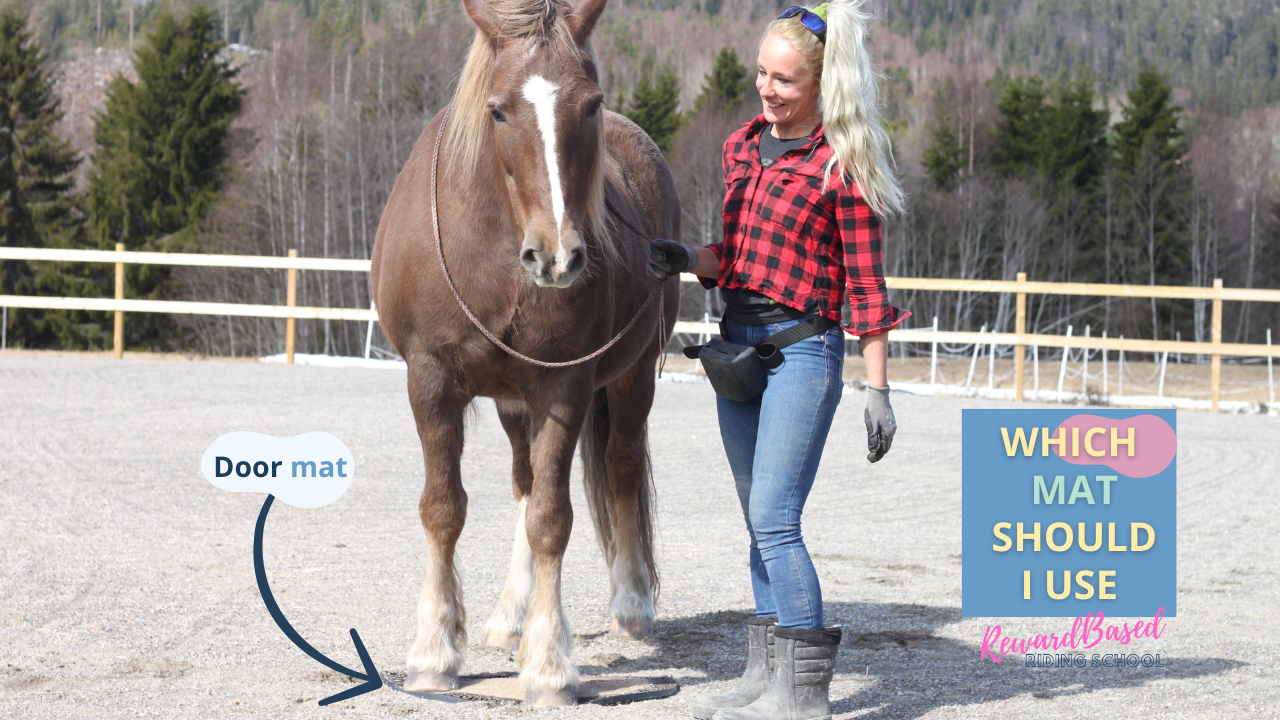Which Mat To Use as a Hoof Target
Jan 25, 2025
Exploring Different Types of Mats for Horse Training
Mats are versatile tools in horse training, offering endless opportunities for teaching, gymnastic exercises, and behavior refinement. Here, we’ll explore the pros and cons of different mats, helping you choose the right one for your horse and training goals. Or just give you ideas or ins to the wonderful mat world.
1. Door Mat
A door mat is a fantastic starting point for mat training. These are affordable, easy to find, and often heavy enough to stay in place during training sessions, even if it’s windy or the horse paws a bit at it. Door mats are small, making them perfect for teaching front-hoof placement and for introducing the concept of standing on a mat without overwhelming the horse in placement possibilities. They’re also highly portable, making them easy to move around for various exercises and combine with movement teachings.
Best For:
-
Beginners teaching mat behaviors.
-
Portable training setups.
Drawbacks:
-
Limited size; also an advantage but of course limiting for full body placement exercises.
2. Folding Gym Mat

A folding gym mat is excellent for taking your training to the next level, particularly for gymnastic exercises. Its larger size allows the horse to step fully onto the mat, and you can fold it up to increase the height as your horse becomes stronger and more body-aware. The IKEA "Plufsig" mat (found in their kids’ department) is an affordable and durable option for this purpose. Horses new to the concept of mats can however find this mat a bit scary and remember to not overdo the standing. It is more work than it looks like for most horses.
Best For:
-
Gymnastic training.
-
Building strength and body awareness.
Drawbacks:
-
Can be scary at first, use when concept is clearer.
-
Bulky and less portable compared to a door mat.
-
May not hold up well to heavy pawing.
- If your horse has shoes...duration is very limited.
3. Plywood Board

A plywood board offers a both a tactile and auditory experience for your horse. The change in surface provides valuable feedback when the horse steps onto it, helping them become more aware of their movement. This type of mat is ideal for both starting mat training as well as progressing to more advanced behaviors, such as leg lifts or weight shifts, as it gives clear sensory cues.
Best For:
-
Tactile and auditory feedback.
-
Advanced groundwork and body awareness exercises.
Drawbacks:
-
May require anti-slip treatment for safety in more damp or rainy areas.
-
Heavier and less convenient to move.
4. Pedestal

A pedestal is a step up—literally—from other mats. It requires the horse to lift themselves onto a higher surface, making it a great tool for gymnastic training and building body awareness. The height and balance required on a pedestal make it particularly useful for halt work and preparing horses for tasks like trailer loading.
Best For:
-
Gymnastic value and body awareness.
-
Preparing for loading and advanced exercises in halt.
Drawbacks:
-
Requires more training to introduce safely and confidently.
-
Less versatile for general mat training.
5. Mats in Different Colors

Using mats in various colors opens up new possibilities for training. You can designate specific colors for different horses or use them to teach different behaviors. For example, one mat might signal halt work, while another indicates specific gymnastic exercises. This method also strengthens your horse’s ability to generalize and differentiate cues.
Best For:
-
Multi-horse training setups.
-
Assigning different behaviors to specific mats.
Drawbacks:
-
Requires advanced training to establish clear associations.
What to Consider When Choosing a Mat
-
Durability: How does it handle different horse sizes or being left out in the rain (valid for me at least)?
-
Portability: Is it easy to move and set up in different environments? I often bring a mat when we go to new places.
-
Size: Does it fit your training goals, from front-hoof or hind hoof placement to full-body exercises?
-
Surface Texture: Is it safe and non-slip for your horse?
-
Purpose: Are you introducing mat behaviors, focusing on gymnastic exercises, or working on advanced tasks?
Happy training!

